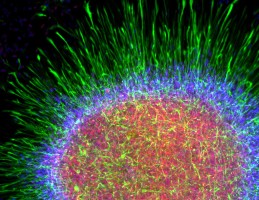Human brain’s most ubiquitous cell cultivated in lab dish
May 22, 2011

Astrocyte progenitors and immature astrocytes cluster to form an "astrosphere" (credit: Robert Krencik/UW-Madison)
University of Wisconsin-Madison researchers have directed embryonic and induced human stem cells to become astrocytes in the lab dish.
The researchers said they are now able to make billions or trillions of astrocytes from a single human pluripotent stem cell cell.
The ability to culture the cells gives scientists a powerful tool to understand astrocytes and devise new therapies and drugs for neurological disorders, the researchers said.
The star-shaped astrocyte, the most common cell in the human nervous system, has received less attention from scientists than the neuron because human astrocytes have been hard to get. There are a variety of astrocyte cell types and they perform such basic housekeeping tasks as helping to regulate blood flow, soaking up excess chemicals produced by interacting neurons, and controlling the blood-brain barrier.
Ref: Robert Krencik, Jason P Weick, et al., Specification of transplantable astroglial subtypes from human pluripotent stem cells, Nature Biotechnology, 2011; DOI: 10.1038/nbt.1877
